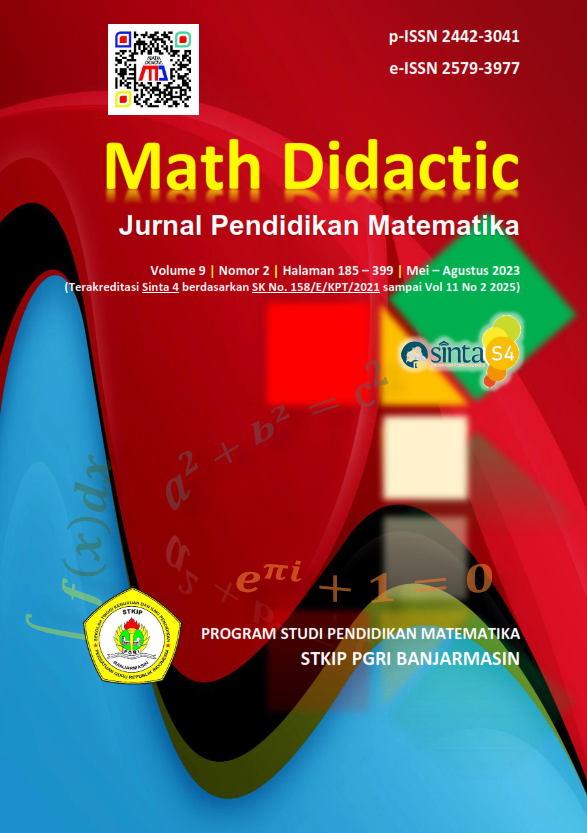The effect of puzzle-based learning on students’ mathematical creative thinking ability and active learning
Pengaruh pembelajaran puzzle-based learning terhadap kemampuan berpikir kreatif dan keaktifan belajar matematis siswa
Abstrak
The focus of this thesis was to analyze the effect of puzzle-based learning on students' mathematical creative thinking ability and active learning. This research was using a quasi-experiment research design with two research teams: the experimental and control classes. This study included those grade VIII students from SMP Insan Cendekia Madani Serpong during the 2022/2023 academic year. The research sample included 32 students of VIIIA as the experiment class and 32 of VIIIB as the control class. A test tool of mathematical creative thinking ability and an active learning survey were utilized to collect the data. A t-test was used to analyze the information collected in this research. In accordance with the analyst results, students of puzzle-based learning have greater mathematical creative thinking ability and active learning compared to those who have scientific learning.
##plugins.generic.usageStats.downloads##
Referensi
Abdelouahab, B. (2016). Enhancing Tertiaty Students’ Creative Thinking Through Educational Puzzles. University Mohamed Kheider of Biskra.
Aisyah, P. N., Nurani, N., Akbar, P., & Yuliani, A. (2018). Analisis Hubungan Kemampuan Pemecahan Masalah Matematis Dan Self Confidence Siswa SMP. Journal On Education, 1(1), 58–65.
Akarsu, B., Slisko, J., & Akarsu, B. (2018). Escaping Bear and Snail : How Ready Are Engineering Students for Puzzle-Based Learning ? Journal of European Education (JEE), 8(1), 1–16.
Asikin, M., Wicahyo, D. P., & Suhito. (2019). Students’ mathematical creative thinking ability in creative problem solving learning based on self-esteem. Unnes Journal of Mathematics Education, 8(1), 8–14. https://doi.org/10.15294/ujme.v8i1.25263
Costa, S. A. (2017). Puzzle-Based Learning: an Approach To Creativity, Design Thinking & Problem Solving. Implications for Engineering Education. Proceedings of the Canadian Engineering Education Association (CEEA), 5–9. https://doi.org/10.24908/pceea.v0i0.7365
Harisuddin, M. I. (2019). Secuil Esensi Berpikir Kreatif & Motivasi Belajar Siswa. Bandung: Pantera Publishing.
Hendriana, H., Rohaeti, E. E., & Sumarmo, U. (2017). Hard Skills dan Soft Skills Matematik Siswa. Bandung: Refika Aditama.
Kadir. (2015). Statistika Terapan: Konsep, Contoh, dan Analisis Data dengan SPSS/ Lister dalam Penelitian. Depok: PT Raja Grafindo Persada.
Klymchuk, S. (2017). Puzzle-based learning in engineering mathematics: students’ attitudes. International Journal of Mathematical Education in Science and Technology, 48(7), 1106–1119. https://doi.org/10.1080/0020739X.2017.1327088
Malherbe, K. (2021). Puzzle Based Learning in Undergraduate Studies. International Journal for Innovation Education and Research, 9(11), 383–397. https://doi.org/10.31686/ijier.vol9.iss11.3525
Meika, I., & Sujana, A. (2017). Kemampuan Berpikir Kreatif Dan Pemecahan Masalah Matematis Siswa Sma. Jurnal Penelitian Dan Pembelajaran Matematika, 10(2), 8–13. https://doi.org/10.30870/jppm.v10i2.2025
Mendikbud. (2016). Peraturan Menteri Pendidikan dan Kebudayaan Republik Indonesia Nomor 21 Tahun 2016.
Meyer, E. F., Falkner, N., Sooriamurthi, R., & Michalewicz, Z. (2014). Guide to Teaching Puzzle-based Learning. London: Springer.
Noprianilubis, J., Panjaitan, A., Surya, E., & Syahputra, E. (2017). Analysis Mathematical Problem Solving Skills of Student of the Grade VIII-2 Junior High School Bilah Hulu Labuhan Batu. International Journal of Novel Research in Education and Learning, 4(2), 131–137. Retrieved from www.noveltyjournals.com
Nurmiasari, I. (2013). Program Bimbingan Pribadi-Sosial Berdasarkan Pendekatan Humanistik untuk Mengembangkan Konsep Diri Peserta Didik (Universitas Pendidikan Indonesia). Retrieved from http://repository.upi.edu/3631/
Purbaningrum, K. A. (2017). Kemampuan Berpikir Tingkat Tinggi Siswa Smp Dalam Pemecahan Masalah Matematika Ditinjau Dari Gaya Belajar. Jurnal Penelitian Dan Pembelajaran Matematika, 10(2), 40–49. https://doi.org/10.30870/jppm.v10i2.2029
Putra, H. D., Akhidayat, A. M., & Setiany, E. P. (2018). Kemampuan Berpikir Kreatif Matematik Siswa SMP di Cimahi. Jurnal Matematika Kreatif - Inovatif, 9(1), 47–53.
Putri, F. E., Amelia, F., & Gusmania, Y. (2019). Hubungan Antara Gaya Belajar dan Keaktifan Belajar Matematika Terhadap Hasil Belajar Siswa. Edumatika: Jurnal Riset Pendidikan Matematika, 2(2), 83. https://doi.org/10.32939/ejrpm.v2i2.406
Siswono, T. Y. E., Hartono, S., & Kohar, A. W. (2018). Effectiveness of project based learning in statistics for lower secondary schools. Egitim Arastirmalari - Eurasian Journal of Educational Research, 2018(75), 197–212. https://doi.org/10.14689/ejer.2018.75.11
Tanujaya, B., Mumu, J., & Margono, G. (2017). The Relationship between Higher Order Thinking Skills and Academic Performance of Student in Mathematics Instruction. International Education Studies, 10(11), 78. https://doi.org/10.5539/ies.v10n11p78
Wibowo, N. (2016). Upaya Peningkatan Keaktifan Siswa Melalui Pembelajaran Berdasarkan Gaya Belajar Di Smk Negeri 1 Saptosari. Elinvo (Electronics, Informatics, and Vocational Education), 1(2), 128–139. https://doi.org/10.21831/elinvo.v1i2.10621
Winda, A., Sufyani, P., & Elah, N. (2018). Analysis of creative mathematical thinking ability by using model eliciting activities (MEAs). Journal of Physics: Conference Series, 1013(1). https://doi.org/10.1088/1742-6596/1013/1/012106
Zaenuri, Nastiti, P. A., & Suhito. (2019). Mathematical Creative Thinking Ability Based on Students’ Characteristics of Thinking Style Through Selective Problem Solving Learning Model with Ethnomathematics Nuanced. Unnes Journal of Mathematics Education, 8(1), 49–57. https://doi.org/10.1007/978-3-319-15347-6_301020






















